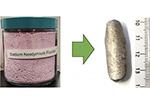
A team of Ames Lab researchers at the Critical Materials Innovation Hub has developed a new, safer, scalable method for producing rare earth metals that utilizes the Ames Process. This new method, Rare Earth Metals from Alternative Fluoride Salt (REMAFS), uses an alternative fluoride salt in the production of rare earth metals, instead of the traditional rare earth salts that are made with harmful hydrofluoric acid (HF). Additionally, the method can be integrated earlier in the rare earth supply chain to reduce the number of steps required to convert mined materials to rare earth metals.
Ikenna Nlebedim, the deputy director of the Division of Critical Materials and a scientist at Ames Lab who led the research group, explained that by eliminating both the use and generation of HF, REMAFS significantly improves safety, environmental impacts, and scalability.
“This process uses rare earth fluoride, but instead of traditional rare earth fluoride, it uses sodium rare earth fluoride. The difference is that sodium rare earth fluoride can be prepared without hydrofluoric acid,” Nlebedim said. “It can be prepared at room temperature, and it is very easy to scale, so you can produce large quantities of it.”
Scalability is often a challenge for researchers developing new materials and processes. It can be challenging to move from an amount processed in the lab to a much larger amount that would be necessary for use in industry applications.
“The ability to easily produce large quantities of materials for the REMAFS process is a key step toward commercial deployment,” explained Denis Prodius, the project lead and a scientist at Ames Lab. “Discussions around large-scale implementation are already underway with the licensee.”
See the full story: Researchers develop a new, non-toxic method for rare earth metal processing
